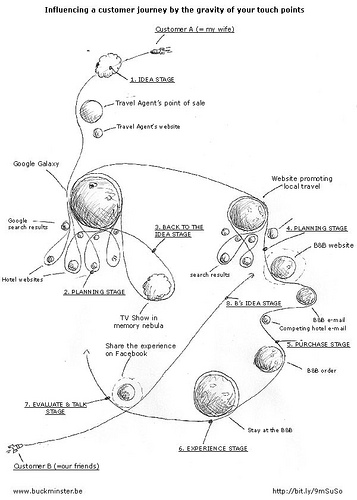
Awesome drawing from Johan vvan Mol depicting the customer journey as it relates to planets.
Google Analytics is a tool that most online marketers are probably familiar with. The statistics that it provides allows people to monitor traffic their website or blog. While this tool’s value is recognized from a traffic-monitoring standpoint, research suggests that it has even greater value.
A recent article discussed how Google Analytics was used to study the process that a customer goes through when buying a product online. The data that this article presented analyzed statistics from 36,000 Google accounts. The information from these compiled statistics revealed valuable trends regarding the typical journey that customers make en route to online purchases.
Different Channel’s Roles
Google’s article analyzed the role that various channels of engagement play in the lead up to customer’s purchases. This analysis broke channel roles into two categories: Assist Interaction and Last Interaction. The first category refers to channels that make people aware of a brand and its products, as well as helps to spark an interest in purchasing. The latter group of channels serves as a final point of contact prior to customers making a purchase.
With Google Analytics, businesses may gather this channel information for themselves. With the knowledge of which channels play particular roles in customer’s decisions to purchase, businesses may better allocate their marketing resources.
Assist Interaction
The Google Analytics report revealed that display ads, email, and social media played more preliminary roles in leading customers to make purchases. Paid search ads, while closer to the threshold for “last interaction” channels, were also preliminary purchase channels. This suggests that when customers interact with brands via these channels, it is still early on in their path to completing a purchase.
Last Interaction
Organic search, direct website visits and referrals represented channels that often served as the final interaction prior to an actual purchase. Of these channels, direct visits proved to be the most conducive to transitioning right into sales, followed by organic search. These results reflect the fact that people searching for a product or visiting website often do so with the intent to make a purchase.
Length of the Journey
Another factor that was analyzed was the way in which the length of a purchase journey is related to the actual purchase’s value. Based on the thousands of analytics accounts analyzed, the report suggests that the length of a purchase journey and the value of the actual purchase are correlated. According to this research, transactions in which 30 days of interaction (assist interaction) took place prior to the purchase yielded the highest value.
Another interesting statistic stated that more than 47% of total revenue from the sales analyzed came from purchasing processes that spanned more than one day. This suggests that for the most valuable sales, customers spend time interacting via channels from both categories (assist and last interaction). For marketers, this indicates that resources must be allocated to both assist and last interaction channels in order to encourage valuable customer purchases.
Your Customer’s Journey
Of the many messages that this research sends to marketers, the most prominent is the value of studying your own customer’s purchasing journeys. If you can pinpoint the most critical marketing channels for your specific business, you can restructure your marketing efforts to be more efficient and profitable.
Is organic search your most prolific final interaction? Then investing in the services of a SEO company (hint hint) may be profitable. Do your customers tend to purchase from direct web visits? Then promoting traffic to your site should be your campaign’s priority. With the aforementioned information at your disposal, you will be able to make more informed marketing decisions and to better understand your customer’s typical purchasing journey.
